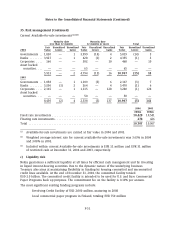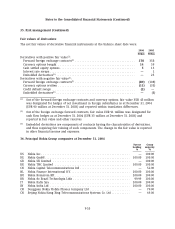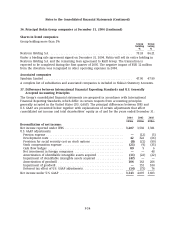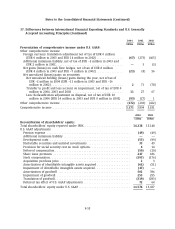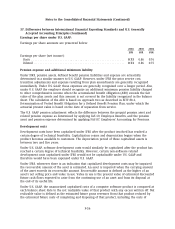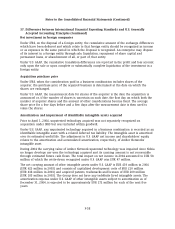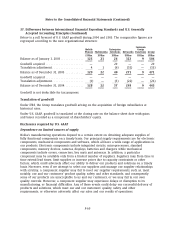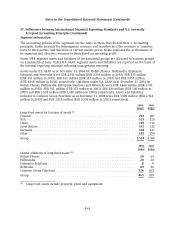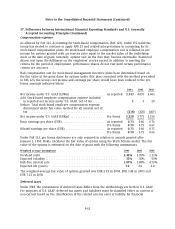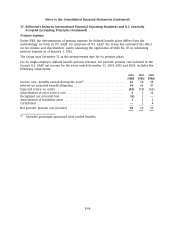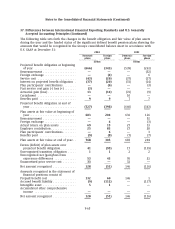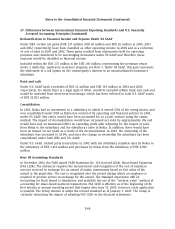Nokia 2004 Annual Report Download - page 185
Download and view the complete annual report
Please find page 185 of the 2004 Nokia annual report below. You can navigate through the pages in the report by either clicking on the pages listed below, or by using the keyword search tool below to find specific information within the annual report.
Notes to the Consolidated Financial Statements (Continued)
37. Differences between International Financial Reporting Standards and U.S. Generally
Accepted Accounting Principles (Continued)
Below is a roll forward of U.S. GAAP goodwill during 2004 and 2003. The comparative figures are
regrouped according to the new organizational structure:
Common
Mobile Enterprise Group
Phones Multimedia Solutions Networks Functions Group
EURm EURm EURm EURm EURm EURm
Balance as of January 1, 2003 .............. 125 21 26 323 9 504
Goodwill acquired ....................... — 20 — — 20
Translation adjustment ................... 4 1 (6) (52) — (53)
Balance as of December 31, 2003 ........... 129 22 40 271 9 471
Goodwill acquired ....................... — — — — — —
Translation adjustment ................... (1) — (3) (22) — (26)
Balance as of December 31, 2004 ........... 128 22 37 249 9 445
Goodwill is not deductible for tax purposes.
Translation of goodwill
Under IFRS, the Group translates goodwill arising on the acquisition of foreign subsidiaries at
historical rates.
Under U.S. GAAP, goodwill is translated at the closing rate on the balance sheet date with gains
and losses recorded as a component of shareholders’ equity.
Disclosures required by U.S. GAAP
Dependence on limited sources of supply
Nokia’s manufacturing operations depend to a certain extent on obtaining adequate supplies of
fully functional components on a timely basis. Our principal supply requirements are for electronic
components, mechanical components and software, which all have a wide range of applications in
our products. Electronic components include integrated circuits, microprocessors, standard
components, memory devices, cameras, displays, batteries and chargers while mechanical
components include covers, connectors, key mats and antennas. In addition, a particular
component may be available only from a limited number of suppliers. Suppliers may from time to
time extend lead times, limit supplies or increase prices due to capacity constraints or other
factors, which could adversely affect our ability to deliver our products and solutions on a timely
basis. Moreover, even if we attempt to select our suppliers and manage our supplier relationships
with scrutiny, a component supplier may fail to meet our supplier requirements, such as, most
notably, our and our customers’ product quality, safety and other standards, and consequently
some of our products are unacceptable to us and our customers, or we may fail in our own
quality controls. Moreover, a component supplier may experience delays or disruption to its
manufacturing, or financial difficulties. Any of these events could delay our successful delivery of
products and solutions, which meet our and our customers’ quality, safety and other
requirements, or otherwise adversely affect our sales and our results of operations.
F-60



